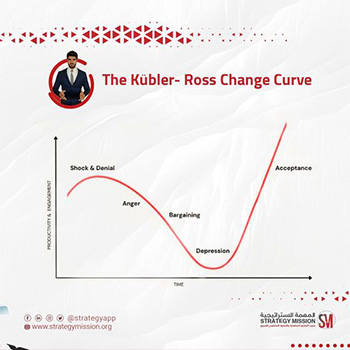Management of organizational change
Congratulations your receipt of the new position as CEO, Division Manager or Supervisor of the Company or Enterprise!
You are now full of energy and enthusiasm to take up your tasks and make a clear difference and change for the better and apply your experiences and knowledge or achieve the goals and expected development, profits and achievements of your managers, owners or partners soon….
At this moment and at the beginning of the business, you may notice that employees do not share the same enthusiasm, especially old ones, especially those with over 5 years of experience in the company, and will therefore face strong resistance from them, which may constitute an obstacle to all the steps and systems of change and improvement that you are trying to apply.
Follow the following article to learn more and plan a successful change God forbid…
To request the services of economic feasibility studies and design and development of business models and production lines through the service of comprehensive strategic analysis and development and marketing plans:
https://strategymission.org/request-services-ar/
The issue of change is no longer a matter of welfare, but it is essential to keep pace with institutional change, as it must be done in an appropriate way, with a conscious understanding of the nature of this process. Among the most important questions that corporate directors and CEOs should ask are:
Why can staff resist change, and what are their hidden motives for it?
- Doubt and lack of trust.
- Emotional interactions.
- Lack of training and sources of assistance.
- Fear of failure.
- Miscommunication.
- Unrealistic schedules.
- The Organization’s current culture and prevailing rules or transformation of habits is difficult to change.
But what is the difference between individual resistance and regulatory resistance?
- Individual resistance occurs when employees resist change based on their perceptions, personalities and individual needs. Factors such as functional security, habits, and economic factors significantly affect individual resistance.
Organizational resistance is the organization’s tendency to resist change and the desire to maintain the current situation. Companies with regulatory resistance become inflexible and unable to adapt to environmental or internal requirements for change. Some signs of organizational resistance include internal conflicts of control and power-taking, poor decision-making processes, uncertain leadership and bureaucratic organizational structures.
7 tips to overcome resistance to change:
Here are some of the best strategies to overcome resistance to change in your organization:
- Presentation of value through education and training
To avoid resistance to change, the evidence was given that the new process or tool would be of great benefit to staff. Teach the team how to improve their lives directly through this change and improve their diaries, and provide continuous training to ensure they feel confident and confident during the transition.
- Collect employees’ opinions before changing
Employees often resist change because they believe their opinions do not matter and will not influence the decision to make an organizational change. Conduct surveys with your team on how they see change and how the process can be facilitated.
- Reaching an agreement with staff
Do not make a decision without consulting those on the front lines – employees. After consulting with your team, reach agreement on the timeline and overall plan for managing and implementing the new change.
- Include staff in change management plan
Employees feel that their opinion is respected when they are included in operations. Make sure you include key members of your team in the change management and implementation process so they feel responsible for the project.
- Staff support during organizational transformation
Don’t leave your staff alone – Support your team members with resources, change management tools, knowledge bases, process training or the new tool you’re implementing. This will help staff to quickly discover value in the new system, building confidence between you.
- Communicate clearly and regularly
To inform staff of changes in the current situation as soon as possible to help build a bridge between staff and management.
Share your information with the employees you can share. If you’re not sure about the answer or simply can’t provide an answer, you can say, for example, “I’ll look it up and get back to you with the answer” or “I’ll share that information with you as soon as I get it.” The more open and frank you communicate with them, the less likely they are to speculate and guess.
- Measuring organizational change performance
Measurement is a key factor in the change process because it allows organizations to understand how implementation affects overall business performance. If the order does not happen as planned, this gives you the opportunity to change the order or include it in the next phase of the change implementation.
Change usually goes through stages of trauma and rejection to anger, objections and constant argument with you and then to frustration and as time passes everyone turns to accept and interact and give trust and few disapproves remain who will be forced to change or will only have to leave the institution.





No comment